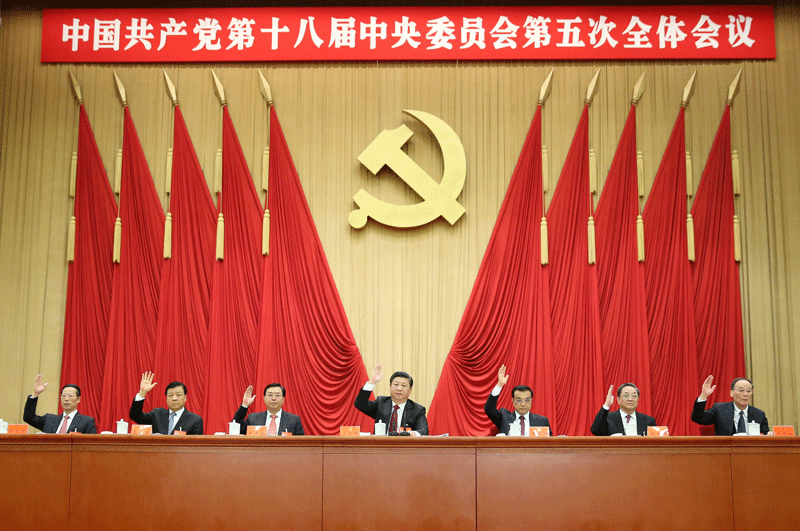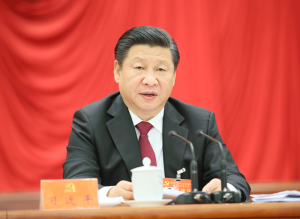 At the recent Fifth Plenum China’s leadership rolled out its proposal for the 13th Five-Year Plan (FYP), the only such plan that will be fully implemented under President Xi Jinping’s term. John Russell of North Head looks at the key outcomes of this meeting and the opportunities that may open up for European companies.
At the recent Fifth Plenum China’s leadership rolled out its proposal for the 13th Five-Year Plan (FYP), the only such plan that will be fully implemented under President Xi Jinping’s term. John Russell of North Head looks at the key outcomes of this meeting and the opportunities that may open up for European companies.
China’s leadership gathered in Beijing from 26th–29th October, for the Fifth Plenum of the 18th Communist Party of China (CPC) Central Committee. The meeting’s main purpose was to approve the Proposals on Formulating the 13th Five-Year Plan (Proposals). The 13th FYP will guide China’s economic and social development from 2016 to 2020, and is the first since Xi launched an ambitious programme of market-orientated reforms at the Third Plenum in 2013. The Proposals provides valuable indications of the government’s priorities and targets for the next five years, ahead of the formal release of the full plan in March 2016.
Takeaways from the Plenum
Central themes from the Fifth Plenum and other recent political developments will impact business. China’s pace of reform will be tempered to allow growth and guarantee stability. This period will be key to redress imbalances of past decades with respect to income disparities, environmental degradation and looming demographic challenges. China’s expanding international footprint, with emphasis on Eurasia, will exert a growing influence on markets. Underpinning these changes is reform of the CPC as an instrument for better governance, shaped by Xi’s robust leadership.
Reform vs. Growth
Drafting of the 13th FYP has taken place in the context of China’s ongoing economic slowdown and efforts to shift to a more sustainable growth model. This deceleration has exacerbated the dislocations that accompany restructuring. It is causing divergent growth across different provinces and sectors. A sharp slowdown that creates unemployment could retard or even derail reform, therefore balancing growth while progressing reform will be a defining theme for years to come.
President Xi announced that annual growth under the 13th FYP will be at least 6.5 per cent to achieve the CPC’s targets of doubling 2010 GDP and income per capita by 2020, in time for the party’s centenary. This is lower than the seven per cent target in the 12th FYP, but remains challenging under current conditions. Language on market reforms in the Proposals is less ambitious than during the Third Plenum, suggesting leadership has more moderate expectations given immediate concerns about growth and volatility. Stability remains the party’s watchword. We can expect the pace of reforms to be recalibrated over the next five years, depending on China’s economic trajectory.
Regarding key engines of growth, the 13th FYP will advance economic restructuring through policies to promote consumption and services. Investment is identified as the critical driver for China’s economy, with continued spending on rebuilding urban areas, roads, railways, pipelines and other infrastructure. Exports are less significant than in prior plans, suggesting the drafting team is not confident external demand will recover sufficiently in the coming five years.
Access and innovation
China has announced that it will implement a nationwide negative list system for foreign investment by 2018, granting pre-establishment national treatment for all sectors not on the list.
Efforts to help Chinese companies climb the global value chain will intensify and China is on track to surpass the EU and the US in R&D spending during the 13th FYP period. Compared to previous indigenous innovation policies, the new approach is more holistic, encompassing not only favourable industrial policies and tax breaks, but also strengthened IPR and efforts to overcome human capital bottlenecks. These policies are designed to nurture national champions to compete globally, consolidating China’s position in such areas as high-speed rail, hydropower and nuclear energy. Policy and financial support offered under such initiatives as Made in China 2025 will help domestic companies gradually close the technology gap with MNCs. China’s drive to boost innovation can also benefit companies that can provide enabling expertise and components.
The government’s traditional top-down approach to R&D dovetails with its new emphasis on nurturing innovation by entrepreneurs and SMEs. An ecosystem of incubators, funding mechanisms and improved IPR protection aims to spur grassroots breakthroughs.
 Re-defining the role of state and market
Re-defining the role of state and market
State-owned enterprises (SOEs) were previously predominant instruments for development, but the government is increasingly embracing the private sector as a vehicle for achieving policy objectives. The Proposals calls for further development of private banks, hospitals, third-party environmental service providers and private-public partnerships for infrastructure investment. Market reforms will see stronger Chinese private enterprises challenging for domestic and overseas markets, but will also create space and business opportunities for MNCs.
Recently-released guidelines call for SOEs to become more profit-orientated and shift to mixed ownership while remaining under the control of the party. Over the 13th FYP and beyond, these reforms will gradually shape SOEs into more efficient competitors, could affect their behaviour in joint ventures and may allow MNCs to forge new strategic partnerships with them. The policy also allows state investment in private companies, which could lead to hybrid private-state enterprises in some sectors.
Addressing imbalances
Overcoming imbalances from the last 30 years of development will be a key theme of the 13th FYP. The social safety net will be strengthened to tackle inequality, with universal coverage for social and critical illness insurance and more rural migrants given access to government services and welfare in cities. A ‘two-child policy’ will ease demographic pressures of an ageing population. While 90 million additional couples will be eligible for a second child, the short-term impact will be tempered by China’s low underlying birth rate. These reforms will generate demand for consumer goods, particularly in smaller cities and interior China.
Balancing development and environmental protection is a top priority in the 13th FYP. Notably, the Proposals aims to reconfigure the chain of command for local environmental protection agencies. This will see them take a more independent and active role in enforcement. Use of market-based instruments will expand, including cap and trade mechanisms for energy consumption, water usage and industrial emissions. These trends will increase business costs in China, but MNCs should be better placed to weather such adjustments and leverage sustainability as a source of competitive advantage. There will be increased opportunities for companies that can provide energy-efficient or emissions-reducing solutions.
Reconfiguring party governance
The central project of Xi’s first term is to strengthen and reconfigure the party for more effective governance. The primary tool for these efforts has been a sweeping anti-corruption campaign that has claimed over 120 senior officials thus far. Moving forward, measures to keep officials in check will become increasingly institutionalised through party rules, strengthening the disciplinary apparatus and building a comprehensive legal system that clearly delineates government powers. Increasing scrutiny on party discipline should help restrain ad hoc interference in business by the government. However, the campaign has had a chilling effect on many areas of government. Officials are more reticent to engage with business and the pace of decision-making has slowed.
The Proposals continues the trend of increasing CPC dominance in policymaking under Xi. It calls for party committees at all levels to play a larger role in overall economic and social planning – an area previously led by the government. This ascendancy is visible in many areas, from party leading groups issuing decisions bypassing state bureaucracy, to the grassroots, such as in Tianjin where reportedly 80 per cent of officials have placed party titles before government titles on name cards to stress duty to the party. Increased influence of party organs will contribute to a faster but less transparent policymaking process.
Three years into his administration, the logic of Xi’s reform strategy is more apparent than ever. China needs a rejuvenated party with a strong leader to implement economic reforms and achieve its international potential. While economic slowdown and market volatility may have caused the leadership to shift the reform process down a gear, evidence from the Fifth Plenum suggests Xi remains very much in the driving seat. No major personnel changes were announced, but this year Xi has been gradually promoting loyal generals to strengthen control over the military. Political horse trading will gather pace leading up to the 19th Party Congress in 2017, when Xi has the chance to further consolidate his position as a host of senior leaders retire.
Significant challenges remain. Xi has presented himself as a transformational leader. This could be questioned if he cannot achieve meaningful progress in reform during the 13th FYP – the only FYP that will be fully implemented under his administration. Xi has thus paid special attention to 13th FYP planning, leading the drafting group for Proposals and introducing it at the plenum – tasks usually shouldered by the Premier.
China’s international footprint and Eurasia
China’s globalisation is expected to reach a significant milestone during the 13th FYP, with effective outbound investment exceeding inbound by some projections. The Proposals calls for accelerated efforts to develop free trade and investment agreements, such as the Comprehensive Agreement on Investment (CAI) currently being negotiated between Beijing and Brussels. The leadership sees deeper integration with the global economy as a source of growth and as an impetus for domestic reform, similar to China’s entry into the World Trade Organization in 2001.
Europe has an important role in China’s globalisation strategy, underscored by the recent flurry of bilateral visits between China and EU countries. China’s leadership sees Europe as a favourable place for Chinese companies to build technological capabilities and serve as a springboard to access developed markets. There is also increasing interest in potential synergies between EU infrastructure plans and the One Belt One Road initiative.
Conclusions
The Fifth Plenum broadly confirms policy directions from the previous two plenums to strengthen the party and shift China to a more sustainable growth model. The Proposals will now feed into the final drafts of regional plans and the national plan to be approved in March. A series of industry-specific FYPs from ministries and industrial associations will follow, fleshing out the national plan’s overarching goals. Companies doing business in China should use these policies and targets as important references. Where possible, they may also seek ways to provide input on these industry plans.
Despite slowing growth, policy directions mapped out for the 13th FYP are generally positive for European companies. Gradual market liberalisation will help to level the playing field for foreign investors. There are opportunities for companies with strengths aligned with government policy objectives, such as innovation and sustainability.
At the same time, MNCs will also have to adapt to slower growth, increasingly fierce competition from SOEs and China’s private sector, and increased regulatory risk stemming from ongoing re-orientation of government agencies toward market supervision. Established business models are challenged by rapid change in China’s markets, accelerated by reforms and disruptive trends such as digital innovation. Increased use of rules-based mechanisms and tightened party discipline is also significantly changing how companies develop government relations. Personal connections remain necessary but are less effective and carry more risk. As such, companies are devising strategies to engage a broader range of stakeholders, conveying business values, activities and partnerships that chime with changing government policy objectives.
North Head is a public affairs and strategic communications consultancy headquartered in Beijing that has a clear China and Asian focus. Its clients are a mix of multinational corporations and governments from China and the Asian region, Europe and North America. Additional information can be found at www.northheadcomms.com. John Russell can be contacted at jrussell@northheadcomms.com



Recent Comments